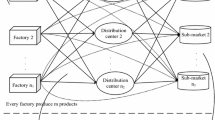Abstract
Motivated by the fact that both long distance and local telephone business are evolving into markets consisting of a few firms having different cost structures and offering multipart pricing schedules, and by the fact that there are almost no analyses of markets of this type in the economics literature, a methodology is developed for the analysis of multipart prices in these markets. The approach makes use of variational inequality theory to model static Nash equilibria in multipart prices, and a marketing type “product space” model for differentiated products imbedded in a discrete choice model framework to model the demand. The approach is designed to be applicable to real world problems; it is flexible and constraints encountered in the real world can be imposed. Two specific models are developed for two-part tariffs, one without resale of services allowed and one allowing for resale. Some qualitative results concerning existence and uniqueness are presented, but the strength of the methodology is quantitative analysis. An algorithm for finding equilibria is presented. An example market representing business WATS is presented to demonstrate the method. The variety of scenarios that can be investigated using the methodology demonstrate its potential to be a very useful tool for the analysis of oligopolistic markets in which multipart prices are prevalent.
Similar content being viewed by others
References
M. Ben-Akiva and S.R. Lerman,Discrete Choice Analysis (The MIT Press, Cambridge, 1985).
S.-C. Choi, W.S. DeSarbo and P.T. Harker, Competitive product positioning: The case of short-term price equilibrium, Working Paper 87-02-05, Department of Decision Sciences, The Wharton School, University of Pennsylvania (1987).
S.-C. Choi, W.S. DeSarbo and P.T. Harker, Product positioning under price competition, Manag. Sci. 36 (1990) 175–199.
S.C. Dafermos, An iterative scheme for variational inequalities, Math. Progr. 26 (1983) 40–47.
S.C. Dafermos, Sensitivity analysis in variational inequalities, Math. Oper. Res. 13 (1988) 421–434.
J.A. Dubin and D.L. McFadden, An econometric analysis of residential electric appliance holdings and consumption, Econometrica 52 (1984) 345–362.
G.M. Duncan, Formulation and statistical analysis of the mixed, continuous/discrete dependent variable model in classical production theory, Econometrica 48 (1980) 839–852.
J. Eliashberg and R. Chatterjee, Analytical models of competition with implications for marketing: Issues, findings, and outlook, J. Mktg. Res. 22 (1985) 237–261.
D. Gabay and H. Moulin, On the uniqueness and stability of Nash equilibria in noncooperative games, in:Applied Stochastic Control in Econometrics and Management Science, eds. A. Bensoussan, P. Kleindorfer and C.S. Tapiero (North-Holland, Amsterdam, 1980).
E. Gal-Or, Oligopolistic nonlinear tariffs, Int. J. Ind. Org. 6 (1988) 199–221.
R.H. Groff and M.K. Perry, Imperfect competition with two-part tariffs: An exploratory model of the business market for communications, Bell Laboratories Economic Discussion Paper (1982).
R.H. Groff and M.K. Perry, Imperfect competition with two-part tariffs: “Product differentiation via pricing”, Bell Laboratories Economic Discussion Paper #203 (1981).
P.T. Harker, A variational inequality approach for the determination of oligopolistic market equilibrium, Math. Progr. 30 (1984) 105–111.
P.T. Harker, Alternative models of spatial competition, Oper. Res. 34 (1986) 410–425.
P.T. Harker and J.-S. Pang, Finite-dimensional variational inequality and nonlinear complementarity problems: A survey of theory, algorithms and applications, Math. Progr. 48 (1990) 161–220.
D. Kinderlehrer and G. Stampacchia,An Introduction to Variational Inequalities and their Applications (Academic Press, New York, 1980).
J. Kyparisis, Sensitivity analysis framework for variational inequalities, Math. Progr. 38 (1987) 203–213.
J. Kyparisis, Perturbed solutions of variational inequality problems over polyhedral sets, J. Optim. Theory Appl. 57 (1988) 295–305.
D. McFadden, The choice theory approach to market research, Mktg. Sci. 5 (1986) 275–297.
B.M. Mitchell, Incremental costs of telephone access and local use, prepared for the Incremental Cost Task Force by RAND Corporation, R-3909-ICTF (1990).
A. Nagurney, Algorithms for oligopolistic market equilibrium problems, Reg. Sci. Urban Econ. 18 (1988) 425–445.
A. Nagurney,Network Economics: A Variational Inequality Approach (Kluwer Academic, Dordrecht, 1993).
S.S. Oren, S.A. Smith and R.B. Wilson, Competitive nonlinear tariffs, J. Econ. Theory 29 (1983) 49–71.
J. Pang and D. Chan, Iterative methods for variational and complementarity problems, Math. Progr. 24 (1982) 284–313.
H.O. Schumann, Oligopolistic nonlinear pricing — A study of trading stamps and airline frequent flyer programs, Unpublished Ph.D. Dissertation, Field of Managerial Economics and Decision Sciences, Northwestern University (1986).
S. Shaffer, Two-part tariffs with free entry, Federal Reserve Bank of New York, Banking Studies Department, Working Paper (1986).
S. Shmanske, Contestable two-part pricing in differentiated duopoly, California State University, Hayword School of Business and Faculty Working Paper (1987).
R.L. Tobin, Sensitivity analysis for variational inequalities, J. Optim. Theory Appl. 48 (1986) 191–204.
Author information
Authors and Affiliations
Rights and permissions
About this article
Cite this article
Tobin, R.L. A method for the analysis of equilibrium multipart prices in oligopolistic markets. Ann Oper Res 44, 195–226 (1993). https://doi.org/10.1007/BF02061067
Issue Date:
DOI: https://doi.org/10.1007/BF02061067




